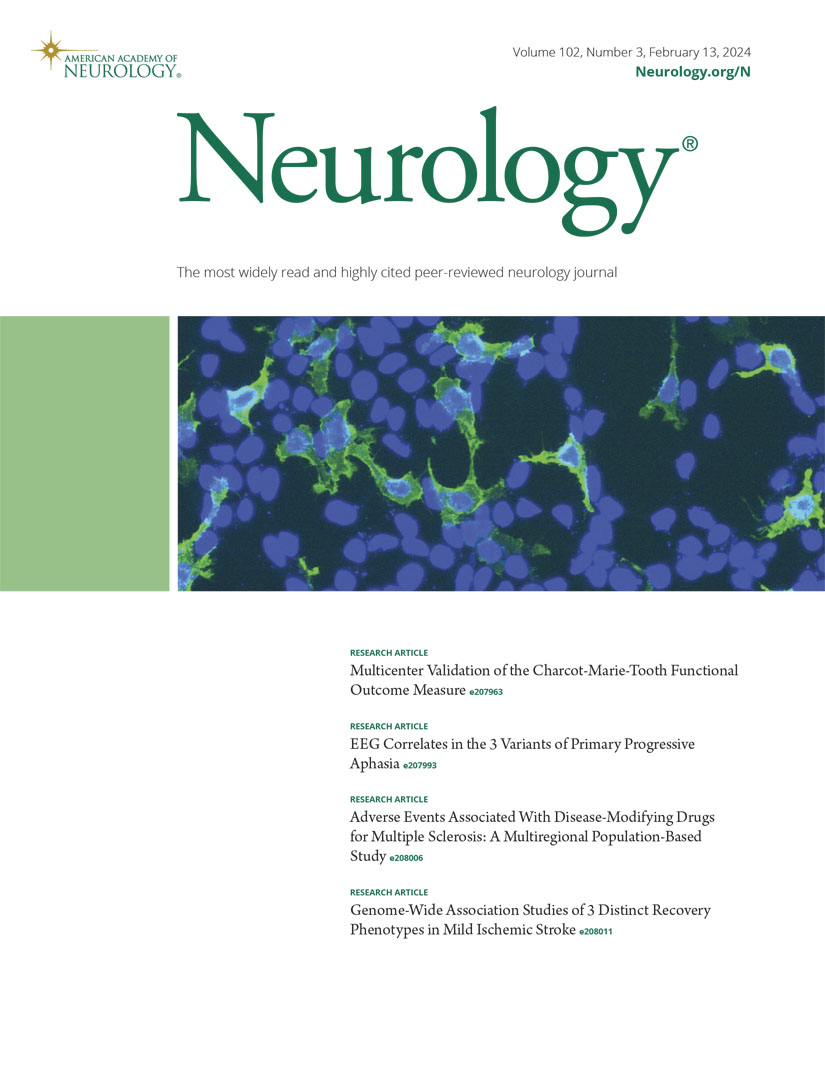Use of the Brain Care Score to Estimate the Risk of Incident Cerebrovascular Events in Middle-Aged Women.
IF 7.7
1区 医学
Q1 CLINICAL NEUROLOGY
引用次数: 0
Abstract
BACKGROUND AND OBJECTIVES In the United States, stroke is the third leading cause of death among women, with 1 in 5 women aged 55 to 75 years expected to experience a stroke. The Brain Care Score (BCS) is an evidence-based tool designed to motivate lifestyle changes, with higher scores associated with reduced risk of stroke, dementia, and depression. We aim to measure the association of the BCS and incident cerebrovascular events (CVEs), including stroke and transient ischemic attack (TIA), in the Women's Health Study (WHS). METHODS The WHS comprises women health professionals aged 45 and older in the United States. Participants without history of CVE and complete data available to calculate a BCS and covariates 5 years after enrollment were included. Higher BCS reflects better risk factor control, with the minimum score being 0 and the maximum score being 20. Cox proportional hazard models examined the association between BCS and incident CVE adjusted for potential confounders. RESULTS A total of 21,271 women were eligible with a median age of 57.9 years (interquartile range: 53.9-63.8) and median BCS of 15 (interquartile range [IQR]:13-16). There were 1,294 incident CVE cases (6.1%) during a median follow-up of 22.4 (IQR: 15.9-23.5) years. A five-point higher baseline BCS was associated with a 37% decrease in the risk of incident CVE after adjusting for age, menopausal status, use of hormonal replacement therapy, and other known cardiovascular disease risk factors (hazard ratio [HR] 0.63, 95% CI 0.56-0.71). This association remained significant after adjusting for race, educational attainment, and income (HR 0.64, 95% CI 0.57-0.72). There was a 28% decreased risk of incident CVE among those with a BCS equal to or above the median compared with those with a BCS below the median, in a fully adjusted model (HR 0.72, 95% CI 0.64-0.80). DISCUSSION Higher baseline BCS was associated with a decreased risk of incident CVE in the WHS. Future studies are needed to study the BCS in more diverse populations and to investigate how changes in BCS across the lifespan affect risk of CVE.用脑保健评分评估中年妇女发生脑血管事件的风险。
背景与目的在美国,中风是女性死亡的第三大原因,55岁至75岁的女性中有五分之一预计会经历中风。脑保健评分(BCS)是一种基于证据的工具,旨在激励生活方式的改变,得分越高,中风、痴呆和抑郁症的风险越低。我们的目的是在妇女健康研究(WHS)中测量BCS与脑血管事件(CVEs)的关联,包括卒中和短暂性脑缺血发作(TIA)。方法WHS包括美国45岁及以上的女性卫生专业人员。入选后5年无CVE病史和可用于计算BCS和协变量的完整数据的参与者。BCS越高,风险因素控制越好,最低分为0分,最高分为20分。Cox比例风险模型检验了BCS与事件CVE之间的关系,调整了潜在的混杂因素。结果共有21,271名妇女符合条件,中位年龄为57.9岁(四分位数范围:53.9-63.8),中位BCS为15(四分位数范围[IQR]:13-16)。在中位随访22.4年(IQR: 15.9-23.5)期间,有1294例CVE事件(6.1%)。在调整年龄、绝经状态、激素替代疗法的使用和其他已知心血管疾病危险因素后,基线BCS升高5点与CVE发生风险降低37%相关(危险比[HR] 0.63, 95% CI 0.56-0.71)。在调整种族、受教育程度和收入后,这种关联仍然显著(HR 0.64, 95% CI 0.57-0.72)。在完全调整的模型中,与BCS低于中位数的患者相比,BCS等于或高于中位数的患者发生CVE的风险降低了28% (HR 0.72, 95% CI 0.64-0.80)。较高的基线BCS与WHS中发生CVE的风险降低相关。未来的研究需要在更多样化的人群中研究BCS,并调查BCS在整个生命周期中的变化如何影响CVE的风险。
本文章由计算机程序翻译,如有差异,请以英文原文为准。
求助全文
约1分钟内获得全文
求助全文
来源期刊

Neurology
医学-临床神经学
CiteScore
12.20
自引率
4.00%
发文量
1973
审稿时长
2-3 weeks
期刊介绍:
Neurology, the official journal of the American Academy of Neurology, aspires to be the premier peer-reviewed journal for clinical neurology research. Its mission is to publish exceptional peer-reviewed original research articles, editorials, and reviews to improve patient care, education, clinical research, and professionalism in neurology.
As the leading clinical neurology journal worldwide, Neurology targets physicians specializing in nervous system diseases and conditions. It aims to advance the field by presenting new basic and clinical research that influences neurological practice. The journal is a leading source of cutting-edge, peer-reviewed information for the neurology community worldwide. Editorial content includes Research, Clinical/Scientific Notes, Views, Historical Neurology, NeuroImages, Humanities, Letters, and position papers from the American Academy of Neurology. The online version is considered the definitive version, encompassing all available content.
Neurology is indexed in prestigious databases such as MEDLINE/PubMed, Embase, Scopus, Biological Abstracts®, PsycINFO®, Current Contents®, Web of Science®, CrossRef, and Google Scholar.
 求助内容:
求助内容: 应助结果提醒方式:
应助结果提醒方式:


